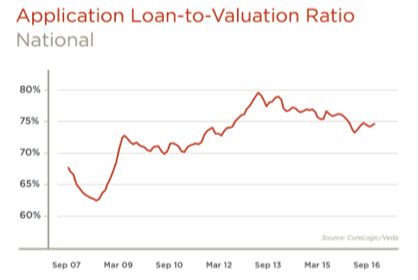New loan-to-valuation index shows home owners are building equity
Contact
New loan-to-valuation index shows home owners are building equity
Loan-to-valuation ratios are tracking lower from a 2013 peak, as homeowners build equity in their properties as prices rise.
The national average application loan-to-valuation ratio across Australia is 74.3%, according to a new index developed by CoreLogic and consumer data company Veda, or 1.7 percentage points higher than the 72.6% recorded in 2011, but significantly lower than the 2013 of 78.9%.
The index compares CoreLogic's median dwelling values with Veda's median residential loan application amount, providing an indicator of application loan-to-valuation ratios across Australia.

Source: CoreLogic, Veda.
Moses Samaha, Veda’s General Manager of Commercial and Property Solutions, said, "In the past 12 months to September, we have seen the national median dwelling valuation rise 5.5% and the median residential loan enquiry amount rise 3.4%."
The downward trend in the application LVR across the country reflects the fact that homeowners are building equity in their properties as prices rise.
“Sydney dwelling values have increased by almost 95% since the beginning of 2009 which has created a large amount of equity for those who have owned a dwelling during this time. High equity is likely one of the key factors that has pushed application LVRs lower in Sydney and to a lesser extent, Melbourne,” Samaha said.
However, Sydney has recently experienced an upswing in its application LVR.
Average application LVRs were mixed around the country. Application LVRs in Canberra and Hobart are flat as housing market conditions improve. Brisbane has also seen the application LVR trend lower after reaching a peak of 80.5% in October 2013.
Tim Lawless, Head of Research at CoreLogic Asia Pacific, said the application LVR index shows Australia has adopted prudent lending standards.
“Regulators and policy makers are likely to see the lower application LVR as a positive outcome, which is reflective of a more considered and prudent lending regime,” said Lawless.
See also:
Major banks' tighter lending deters foreign buyers





